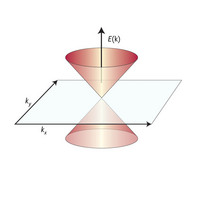Home > Press > The indecisive insulator
 |
| Figure 1: In two dimensions, the electronic energy band in graphene follows a cone-shaped distribution, similar to the behavior of relativistic massless Dirac fermions. |
Abstract:
Researchers are applying relativistic quantum theory to explain how graphene could switch from a metal to an insulator
The indecisive insulator
Japan | Posted on January 10th, 2008Graphene, which consists of single sheets of carbon atoms peeled off graphite, has recently been fabricated for the first time. Graphene has unusual electrical properties that originate from the unconventional manner in which its electrons behave. A team from the University of California, the Paul Scherrer Institute in Switzerland and the RIKEN Discovery Research Institute in Wako are gaining insight into graphene by expanding the quantum theory for relativistic particles1.
Electron transport in solids is usually non-relativistic and governed by the Schrödinger equation. However the electrons in graphene effectively behave like massless relativistic particles, which are described by a Dirac equation. This means that in two dimensions the electronic energy band is cone-shaped (Fig. 1), and gives graphene the potential to switch from a conducting metal to an insulator.
"Electrons are scattered randomly by impurities and defects in a solid," explains project-member Akira Furusaki from RIKEN. "When such scattering happens sufficiently frequently, electrons become localized in a finite region and cannot propagate over a distance. This phenomenon is called Anderson localization."
During Anderson localization, the wavefunction—or probability distribution of different states—of an electron is very narrow in space. If all the electrons in a solid are Anderson localized, the solid is an insulator. In contrast, electrons in a conducting metal are free to move, having wavefunctions extended over the entire system.
Furusaki and co-workers extended an aspect of quantum field theory called the nonlinear sigma model to examine Anderson localizations in graphene. The model is defined whenever electrons move by diffusion, and has been a standard tool to describe transport properties of electrons in disordered solids.
The researchers discovered that when the nonlinear sigma model is used to describe the transport of two-dimensional Dirac electrons in a random electrostatic potential, a topological term is required in the mathematical formulation (at the same time, a German and Russian team reached a similar conclusion independently2).
The topological term arises from Majorana fermions—theoretical particles that are their own antiparticles—originating in the theory of the Anderson localization in graphene. "The presence of a topological term can change low-energy (long-distance) properties of the model drastically and is responsible for metallic transport in graphene," says Furusaki.
In future the researchers hope to generalize their theory to three dimensions. "We also plan to examine other systems such as disordered superconductors," says Furusaki, "in which the transport of low-energy quasiparticles may be highly complex."
Reference
1. Ryu, S., Mudry, C., Obuse, H. & Furusaki, A. Z2 topological term, the global anomaly, and the two-dimensional symplectic symmetry class of Anderson localization. Physical Review Letters 99, 116601 (2007). | article |
2. Ostrovsky, P.M., Gornyi, I.V. & Mirlin, A.D. Quantum criticality and minimal conductivity in graphene with long-range disorder. Physical Review Letters 98, 256801 (2007).
####
About RIKEN
RIKEN is one of Japan’s largest research organisations with institutes and centres in various locations in Japan (see http://www.riken.jp/engn/r-world/link/index.html). RIKEN’s 3000+ researchers publish several hundred research articles in top scientific and technical journals every year across a broad spectrum of disciplines in physics, chemistry, biology, medicine, earth science and in many areas of technology, and the number of articles is growing year on year.
For more information, please click here
Copyright © RIKEN
If you have a comment, please Contact us.Issuers of news releases, not 7th Wave, Inc. or Nanotechnology Now, are solely responsible for the accuracy of the content.
| Related News Press |
Discoveries
![]() Chemical reactions can scramble quantum information as well as black holes April 5th, 2024
Chemical reactions can scramble quantum information as well as black holes April 5th, 2024
![]() New micromaterial releases nanoparticles that selectively destroy cancer cells April 5th, 2024
New micromaterial releases nanoparticles that selectively destroy cancer cells April 5th, 2024
![]() Utilizing palladium for addressing contact issues of buried oxide thin film transistors April 5th, 2024
Utilizing palladium for addressing contact issues of buried oxide thin film transistors April 5th, 2024
Announcements
![]() NRL charters Navy’s quantum inertial navigation path to reduce drift April 5th, 2024
NRL charters Navy’s quantum inertial navigation path to reduce drift April 5th, 2024
![]() Discovery points path to flash-like memory for storing qubits: Rice find could hasten development of nonvolatile quantum memory April 5th, 2024
Discovery points path to flash-like memory for storing qubits: Rice find could hasten development of nonvolatile quantum memory April 5th, 2024
Quantum nanoscience
![]() Simulating magnetization in a Heisenberg quantum spin chain April 5th, 2024
Simulating magnetization in a Heisenberg quantum spin chain April 5th, 2024
![]() Optically trapped quantum droplets of light can bind together to form macroscopic complexes March 8th, 2024
Optically trapped quantum droplets of light can bind together to form macroscopic complexes March 8th, 2024
![]() Bridging light and electrons January 12th, 2024
Bridging light and electrons January 12th, 2024
![]() 'Sudden death' of quantum fluctuations defies current theories of superconductivity: Study challenges the conventional wisdom of superconducting quantum transitions January 12th, 2024
'Sudden death' of quantum fluctuations defies current theories of superconductivity: Study challenges the conventional wisdom of superconducting quantum transitions January 12th, 2024
|
|
||
|
|
||
| The latest news from around the world, FREE | ||
|
|
||
|
|
||
| Premium Products | ||
|
|
||
|
Only the news you want to read!
Learn More |
||
|
|
||
|
Full-service, expert consulting
Learn More |
||
|
|
||








